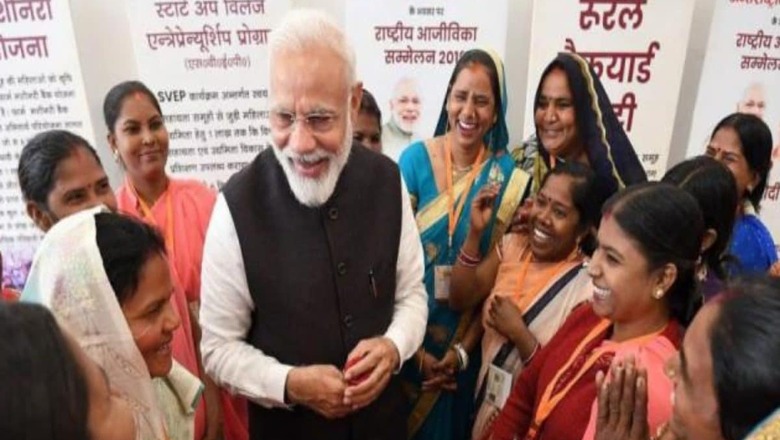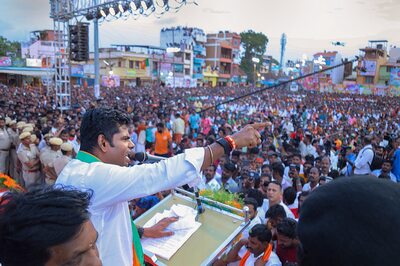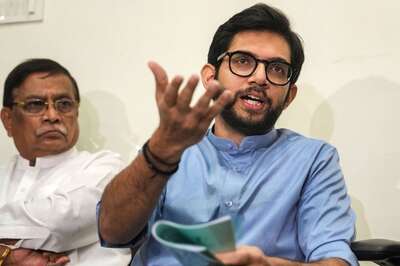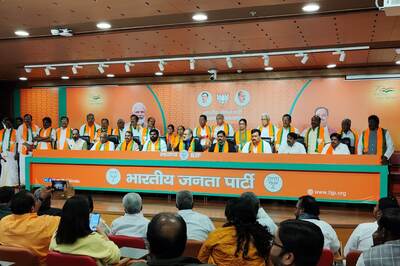
views
On January 30, the Centre directed employers to implement digital payment of wages and provide 26 weeks of paid maternity leave to women construction workers. The Ministries of Road Transport and Highways (MoRTH) and Housing and Urban Affairs issued advisories to agencies under their purview, urging them to promote workforce participation through these measures.
In coherence, in a groundbreaking decision with significant socio-economic implications, the Centre announced that female employees can now nominate their sons or daughters for family pension instead of their husbands. The official statement, released on Monday, emphasised the alteration in family pension rules for government servants or pensioners.
Along with it, the Union Ministries of Labour & Employment and Women & Child Development have initiated a collaborative survey to analyse the augmentation of women’s participation in the workforce.
Union Minister Smriti Irani announced the survey in New Delhi during the ‘Women in the Workforce for Viksit Bharat’ event. The objective of the survey is to evaluate the prevalence of women-friendly practices among employers in the country. Concerns raised by various international agencies and trade unions, including the International Labour Organisation, regarding the declining involvement of female workers in the country, prompted the survey.
Since time immemorial, legislations grounded in equality, which guarantee equal rights and protection against discrimination for every Indian woman under the Constitution, have been enacted and facilitated. These laws play a pivotal role in reshaping societal values, operational mechanisms, and perceptions, ensuring women’s access to education, healthcare, and justice, constituting half the nation’s population.
In the contemporary era, there has been a notable expansion of women’s participation in the public sphere. Increasing numbers of Indian women have assumed roles in the workforce, actively engaging in business enterprises, banking, trade, international forums, and diverse careers such as advertising and fashion. They have demonstrated their capabilities as legislators, bureaucrats, judges, lawyers, doctors, engineers, accountants, and more. Women advocate for robust laws and legislations that empower them as significant contributors to nation-building.
Under the strong leadership of Prime Minister Modi, the government has played a key role in fortifying the position of Indian women. Since 2014, a series of women-centric legislations and legal reforms have been introduced, contributing to the empowerment and upliftment of women in India. Under the Modi government, women have been given greater appreciation and better protection. Since the BJP came to power in 2014, the protection of women’s rights has become one of the key focus areas of the government.
Maternity Leave for Construction Workers
The Modi government on Tuesday announced that employers shall provide 12 weeks of paid maternity leave for individuals with more than two children or for those adopting or commissioning mothers. The advisories also address miscarriages, stating that in the construction sector, if a woman undergoes a miscarriage, she is entitled to leave with wages equivalent to maternity benefits for six weeks from the day of the miscarriage.
The advisory issued by the MoRTH said, “For ensuring wide participation of women and providing gender equal opportunities in the highway sector, MoRTH has decided to issue an Advisory in line with the Statutory Provisions to all implementing agencies, which in turn, shall ensure and oversee the adoption of the Advisory by their respective contractors/concessionaires”.
Employers in the highways sector are urged to ensure facilities such as latrines and urinals, washing areas, crèches, and adequate accommodation for migrant women workers in accordance with the provisions of the Inter-State Migrant Workmen (Regulation of Employment and Conditions of Service) Act and Rules. The advisory underscores the proactive responsibility of employers in implementing policies and programs to encourage women’s participation in the workforce.
Changes in Pension Nominee
The Centre has granted female government employees the authority to nominate their eligible child/children for family pension instead of their husbands. The Department of Pensions and Pensioners’ Welfare (DoPPW) introduced an amendment to the Central Civil Services (Pension) Rules, 2021, allowing female government employees or pensioners to assign family pension rights to their eligible child/children in the event of their demise. This replaces the previous provision where the spouse was the primary recipient, and other family members qualified only under specific circumstances.
Union Minister of State for Personnel, Jitendra Singh, highlighted that this amendment aligns with Prime Minister Modi’s commitment to ensuring equal rights for women. The amendment addresses situations arising from marital discord, divorce proceedings, or legal cases under laws such as the Protection of Women from Domestic Violence Act, Dowry Prohibition Act, or the Indian Penal Code. This ensures fair and just family pension allocation even in complex family situations.
According to the DoPPW, a female government servant or pensioner must submit a written request to the concerned head of the office, specifying that family pension should be granted to her eligible child or children in precedence to her spouse in case of her demise during ongoing proceedings. If the female government servant or pensioner passes away during the proceedings, the family pension will be disbursed accordingly.
The statement clarified various scenarios for family pension distribution. If a woman employee is survived by a widower with no eligible child, the family pension will be payable to the widower. However, if the widower is the guardian of a minor child or a child with a mental disorder, the family pension will be payable to the widower as long as he remains the guardian. Once the child attains majority and remains eligible for family pension, it will be payable directly to the child.
This decision marks a significant step towards gender equality and empowerment, aligning with the government’s commitment to providing just and legitimate rights to women in various sectors. The amendment not only addresses legal complexities but also reflects a broader effort to create a more inclusive and supportive environment for women in the workforce.
Women’s Participation in Workforce
As a result of the number of legislative changes, women’s participation in the labour force has increased substantially. The Ministry of Statistics and Programme Implementation, in its release of the Periodic Labour Force Survey Report 2022-23, highlighted a noteworthy 4.2 percentage point increase, pushing the Female Labour Force Participation Rate (FLFPR) to 37.0 per cent in 2023.
Under the current survey being undertaken by the Labour Ministry, the government is requesting information on the establishment of an Internal Complaints Committee (ICC) for the Prevention of Sexual Harassment at the Workplace (POSH), the provision of crèche facilities for children, ensuring equal pay for equal work, offering flexible or remote working hours for women, and providing transportation facilities during late hours.
All of it is indicative of the important role that women have played and continue to play for the country’s development and on the part of the government is an exercise to provide an equitable workplace environment and safeguards for the female section of the society.
The growth in the female LFPR indicates a positive shift in the dynamics of the country’s labour force, with more women actively participating in the workforce. The substantial increase in FLFPR is seen as a significant step towards women’s empowerment and their active involvement in India’s socio-economic and political development, according to the press release.
The Government of India has taken decisive actions to promote women’s engagement in the workforce, concentrating on their long-term well-being. The comprehensive approach covers various stages of women’s lives, including significant initiatives targeting girls’ education, skill development, entrepreneurship facilitation, and ensuring workplace safety, as highlighted in the press release. Government policies and legislation in these domains have played a pivotal role in advancing the agenda of women-led development. By promoting opportunities for women in education, skills, and entrepreneurship, and ensuring a safe and supportive working environment, the government has laid the foundation for a more inclusive and gender-equal workforce.
The increase in FLFPR not only mirrors the growing participation of women in the labour force but also signifies a broader societal transformation, where women are increasingly contributing to the nation’s progress and their own empowerment.
Providing Women Equity since 2014 in the workplace
Several reforms have been undertaken by the current government to empower women and safeguard their rights. Some of them are:
- In 2017, the government achieved a milestone by amending the Maternity Benefit Act, 1961, extending paid maternity leave from 12 to 26 weeks for women employees with fewer than two surviving children. The amendment allowed flexibility in taking up to 8 weeks before the expected delivery date and the remainder after childbirth. It also granted 12 weeks of paid maternity leave for women expecting their third child.
This amendment addressed the needs of adopting and commissioning mothers, allowing them 12 weeks of maternity leave from the date of receiving the child. Provisions for work from home were introduced after completing 26 weeks of leave, subject to work profiles and employer consent. Establishments employing 50 or more employees were mandated to have a crèche with specified facilities. Women employees had the right to visit the crèche four times a day.
- In 2018, the Criminal Law Amendment Act strengthened anti-rape laws, increasing the minimum punishment for rape from seven to ten years and introducing stricter penalties for rape on women under sixteen or twelve years. Death penalty became applicable in certain cases. The amendment aimed at speedy trials and investigations, mandating completion within two months and disposal of appeals within six months.
- The Muslim Women (Protection of Rights on Marriage) Act, 2019, declared the practice of triple talaq as void and illegal. It made the declaration of ‘talaq’ a cognisable offence, attracting up to three years imprisonment and a fine. The act allowed married Muslim women to seek custody of minor children and receive subsistence allowance.
- In 2018, the Finance Ministry incentivised the employment of more women in the formal sector by amending the Employees Provident Fund and Miscellaneous Provisions Act, 1952. The amendment reduced women employees’ contribution to 8 per cent for the first three years of their employment.
These legislative reforms aimed to eliminate gender-based discrimination and create a more women-friendly work environment, aligning with the principles of the Constitution of India.
Transformative Policies and Progress
In the post-2014 era, the Indian government, led by Prime Minister Narendra Modi, has orchestrated transformative policies, significantly elevating gender equity and women’s empowerment. Crucial reforms, such as extended maternity leave and the empowerment of female government employees in family pension decisions, have bolstered the well-being and rights of women in the workforce.
The upswing in the FLFPR to 37.0 per cent in 2023, evident in the Periodic Labour Force Survey Report, is a testament to the success of these strategic interventions. The government’s proactive stance, exemplified by initiatives like the collaborative survey between the Ministries of Labour & Employment and Women & Child Development, showcases a responsive approach to global concerns regarding declining female workforce participation.
Legislation championing equality and protection against discrimination has not only reshaped societal norms but has also been instrumental in fostering women’s active engagement across diverse careers. The sweeping reforms in maternity benefits, protection against sexual harassment, and stringent measures against crimes underscore a resolute commitment to creating a safer and more supportive work environment.
Recent advisories amplify the government’s dedication to fostering equitable workplace conditions. The journey since 2014 encapsulates a positive evolution, emphasising women-led development and contributing to a more inclusive and gender-equal workforce. This period marks a definitive stride towards realising the vision of a nation where women thrive in every sector, underlining the government’s unwavering commitment to empowerment and equitable opportunities for all women.
Views expressed in the above piece are personal and solely that of the author. They do not necessarily reflect News18’s views.




















Comments
0 comment